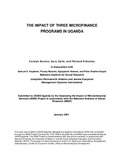| dc.description.abstract | During the last decade there has been an upsurge in attention to the provision of
microfinance services to microentrepreneurs, especially those from poor households. While the
missions of the programs providing the services may vary, most center on improving the
economic conditions of the poor. Also there has been attention to the establishment of viable and
sustainable organizations that provide microfinance services. By covering their operational costs
through interest and fee payments, these organizations have the potential to be sustaining.
The growth of microfinance organizations has been accompanied by expectations about the
impact of these programs on clients. In the past few years the number of methodologically sound
studies of the impact of microfinance programs has increased. These studies provide a better
base for understanding the impacts of microfinance programs that take into account their
strategies, products, and context.
This assessment of three microfinance programs in Uganda seeks to broaden an understanding of
whom these programs reach and their impacts. In particular it looks at impacts on the enterprise,
household, and client. | en_US |

